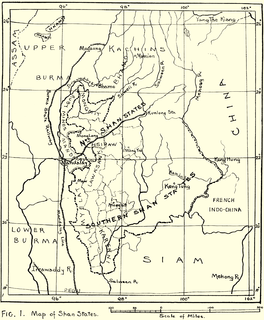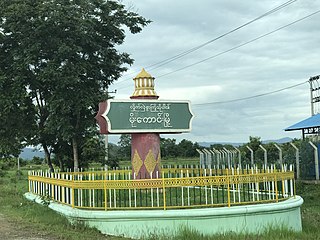
The Shan people or Tai Shan or Tai Yai are a Tai ethnic group of Southeast Asia. The Shan live primarily in the Shan State of Burma (Myanmar), but also inhabit parts of Mandalay Region, Kachin State, and Kayin State, and in adjacent regions of China, Laos, Assam and Thailand. Though no reliable census has been taken in Burma since 1935, the Shan are estimated to number 4–6 million, with CIA Factbook giving an estimate of five million spread throughout Myanmar.

Chao Pha or Chao Fa (literally meaning "lord of the heavens"Chao Fa was a royal title used by the hereditary rulers of the Tai peoples of Mong Dun, Mong Shan, Mong Mao, kingdoms of Mueang Thai and Tai-Khamti people. It is the Thai equivalent. Chao means "master" or "lord", and Fa means "sky" or "heaven". According to local chronicles, some fiefdoms of saophas date from as early as the 2nd century BCE; however, the earlier sections of these chronicles are generally agreed to be legendary.

Hkamti Long was a Shan state in what is today Burma. It was an outlying territory, located by the Mali River, north of Myitkyina District, away from the main Shan State area in present-day Kachin State. The main town was Putao.

The Shan States (1885–1948) were a collection of minor Shan kingdoms called muang whose rulers bore the title saopha in British Burma. They were analogous to the princely states of British India.

Mogaung is a town in Kachin State, Myanmar. It is situated on the Mandalay-Myitkyina railway line.
Bhamo District is a district of the Kachin State in northern Burma (Myanmar). The capital is the city of Bhamo. The district covers an area of 10,742.9 km2. In 2002, the population of the Bhamo District was an estimated 363,300. The district consists of four townships:

Mohnyin is a town in Kachin State, Myanmar. It is the administrative center for both Mohnyin Township and Mohnyin District.

Not to be confused with Bhamo, aka Banmaw

Momeik, also known as Mong Mit in Shan, is a town situated on the Shweli River in northern Shan State of Myanmar (Burma).
Narapati I of Ava was king of Ava from 1442 to 1468. In the early years of his reign, this former viceroy of Prome (Pyay) was forced to deal with raids from the Shan State of Mogaung as well as the Ming Chinese intrusions into Avan territory (1444–1446). In the wake of renewed Chinese determination to pacify the Yunnan frontier region, Narapati was able to maintain Ava's control of northern Shan States of Kale and Mohnyin, and gained allegiance of Thibaw. However, he continued to have trouble with Toungoo which was in revolt between 1451 and 1459. One of his grandsons attempted on his life in June 1467. The king fled Ava for Prome and died there in July 1468.
Sawlon of Mohnyin was saopha of the Shan state of Mohnyin in the early the 16th century. He is best remembered in Burmese history as the conqueror of Ava Kingdom.

The Sino-Burmese War, also known as the Qing invasions of Burma or the Myanmar campaign of the Qing dynasty, was a war fought between the Qing dynasty of China and the Konbaung dynasty of Burma (Myanmar). China under the Qianlong Emperor launched four invasions of Burma between 1765 and 1769, which were considered as one of his Ten Great Campaigns. Nonetheless, the war, which claimed the lives of over 70,000 Chinese soldiers and four commanders, is sometimes described as "the most disastrous frontier war that the Qing dynasty had ever waged", and one that "assured Burmese independence". Burma's successful defense laid the foundation for the present-day boundary between the two countries.

Kengcheng or Keng Cheng was one of the Shan states. In 1896, part of Keng Cheng was incorporated into the neighbouring state of Kengtung in what is today Burma, and the other part, which is now in Laos, went to French Indochina.
Tai Laing, pronounced Tai Lai or regionally Tai Nai, is a Tai language of Burma, related to Khamti. It has its own script, and, though not taught in schools, is experiencing a cultural revival, albeit still small. There is no census of speakers, but they are estimated to number around 100,000.
Hkonmaing was saopha of the Shan principality of Onbaung–Hsipaw in what is now Myanmar. He was the only main ally of King Narapati II of Ava in the latter's 25-year struggle against the Mohnyin-led Confederation of Shan States, Prome and Toungoo. After Ava's fall, he became a member of the Confederation. He died during or shortly after his participation in the Confederation's 1542 campaign against Toungoo Dynasty. His son, also named Hkonmaing, and grandson Narapati III became kings of Ava.

Hsipaw (သီႇပေႃႉ) was a Shan state in what is today Myanmar. Its capital was Hsipaw town. Hsipaw State was perhaps one of the most well known and powerful saopha Shan States.

Mongmit or Möngmit was a Shan state in the Northern Shan States in what is today Burma. The capital was Mongmit town. The state included the townships of Mongmit and Kodaung.

Hsenwi was a Shan state in the Northern Shan States in what is today Burma. The capital was Hsenwi town.

Kengtung, known as Menggen Prefecture or Möng Khün Chiefdom or Mueng Khuen Fu from 1405 to 1895, was a Shan state in what is today Burma. The capital and the residence of the ruler was Kengtung in the centre of the state. It was the only urban area in this mountainous state whose landscape is dominated by the Daen Lao Range.

Wanmaw, Manmaw or Banmaw (Bhamo) was a Shan state in what is today Burma. It was an outlying territory, located away from the main Shan State area in present-day Kachin State close to the border with China.











